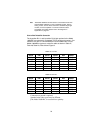30
5.3 POWER-UP
There is no power switch on the Model 1080ARC. Power is automati-
cally applied to the Model 1080ARC when its card-edge connector
makes contact with the chassis’ mid-plane socket, or when the chassis’
power supply is turned on.
Note The Model 1080ARC is a “hot swappable” card—it will not be
damaged by plugging it in or removing it while the rack is pow-
ered up.
When the local and remote Model 1080ARCs are both powered up and
are passing data normally, the following LED conditions will exist:
• PWR = green
• TD & RD = flashing red and green
• RTS & CD = green
• TEST = off
5.4 TEST MODES
The Model 1080ARC offers two V.54 test modes and two V.52 test
modes to evaluate the condition of the modems and the communication
link. Both sets of tests can be activated physically from the front panel.
The V.54 test can also be activated from the RS-232 interface.
Note V.54 and V.52 test modes on the Model 1080ARC are available
for point-to-point applications only.
Local Analog Loopback (LAL)
The Local Analog Loopback (LAL) test checks the operation of the local
Model 1080ARC, and is performed separately on each unit. Any data
sent to the local Model 1080ARC in this test mode will be echoed
(returned) back to the user device. For example, characters typed on the
keyboard of a terminal will appear on the terminal screen. To perform a
LAL test, follow these steps:
1. Activate LAL. This may be done in one of two ways: First, by mov-
ing the upper front panel toggle switch RIGHT to “Analog”. Second,
by raising pin 18 on the RS-232 interface (note: be sure DIP switch
S1-6 is enabled). Once LAL is activated, the Model 1080ARC trans-
mit output is connected to its own receiver. The “Test” LED should
be lit.
2. Verify that the data terminal equipment is operating properly and can
be used for a test.


















